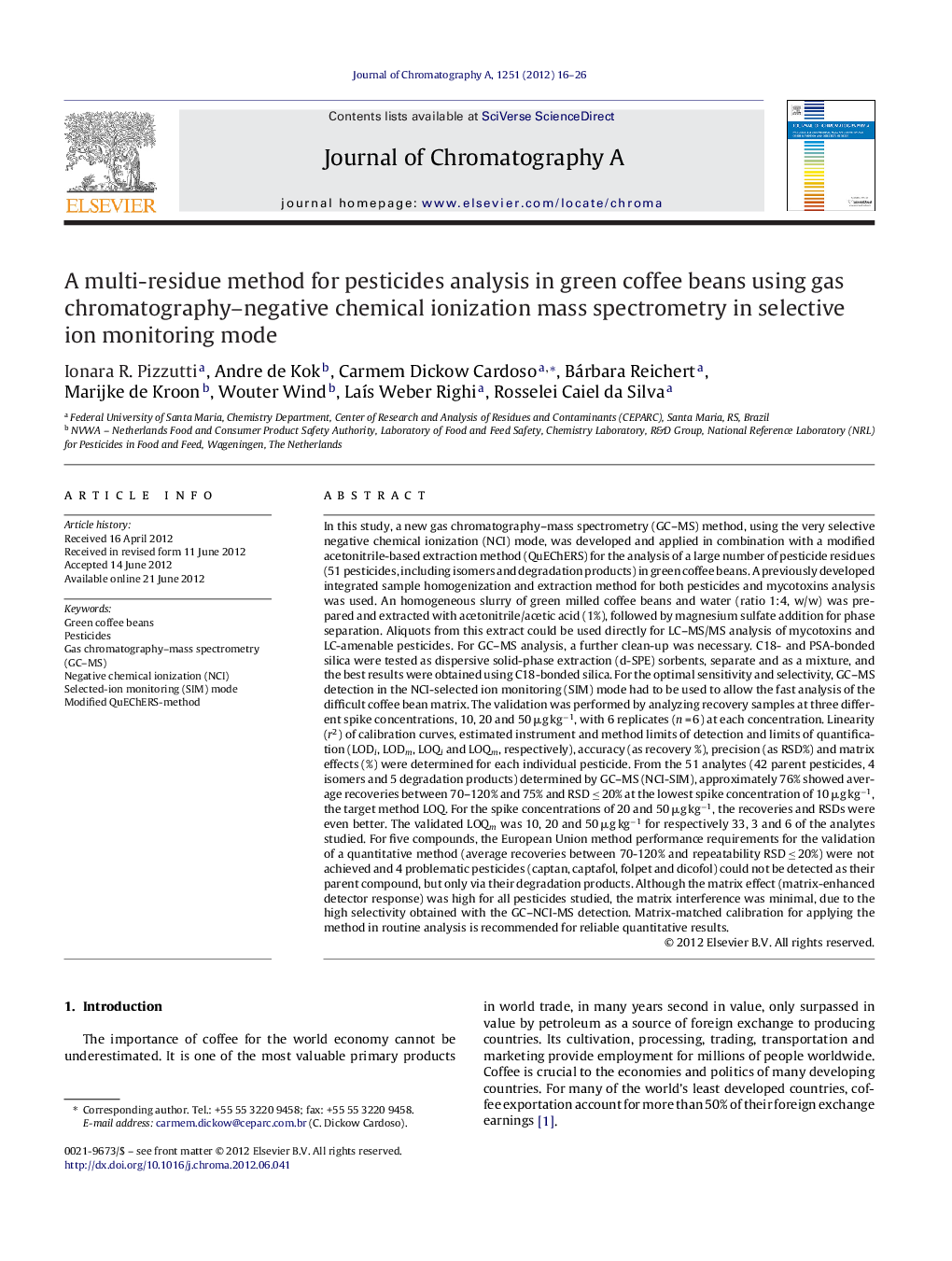| کد مقاله | کد نشریه | سال انتشار | مقاله انگلیسی | نسخه تمام متن |
|---|---|---|---|---|
| 1202381 | 1493674 | 2012 | 11 صفحه PDF | دانلود رایگان |

In this study, a new gas chromatography–mass spectrometry (GC–MS) method, using the very selective negative chemical ionization (NCI) mode, was developed and applied in combination with a modified acetonitrile-based extraction method (QuEChERS) for the analysis of a large number of pesticide residues (51 pesticides, including isomers and degradation products) in green coffee beans. A previously developed integrated sample homogenization and extraction method for both pesticides and mycotoxins analysis was used. An homogeneous slurry of green milled coffee beans and water (ratio 1:4, w/w) was prepared and extracted with acetonitrile/acetic acid (1%), followed by magnesium sulfate addition for phase separation. Aliquots from this extract could be used directly for LC–MS/MS analysis of mycotoxins and LC-amenable pesticides. For GC–MS analysis, a further clean-up was necessary. C18- and PSA-bonded silica were tested as dispersive solid-phase extraction (d-SPE) sorbents, separate and as a mixture, and the best results were obtained using C18-bonded silica. For the optimal sensitivity and selectivity, GC–MS detection in the NCI-selected ion monitoring (SIM) mode had to be used to allow the fast analysis of the difficult coffee bean matrix. The validation was performed by analyzing recovery samples at three different spike concentrations, 10, 20 and 50 μg kg−1, with 6 replicates (n = 6) at each concentration. Linearity (r2) of calibration curves, estimated instrument and method limits of detection and limits of quantification (LODi, LODm, LOQi and LOQm, respectively), accuracy (as recovery %), precision (as RSD%) and matrix effects (%) were determined for each individual pesticide. From the 51 analytes (42 parent pesticides, 4 isomers and 5 degradation products) determined by GC–MS (NCI-SIM), approximately 76% showed average recoveries between 70–120% and 75% and RSD ≤ 20% at the lowest spike concentration of 10 μg kg−1, the target method LOQ. For the spike concentrations of 20 and 50 μg kg−1, the recoveries and RSDs were even better. The validated LOQm was 10, 20 and 50 μg kg−1 for respectively 33, 3 and 6 of the analytes studied. For five compounds, the European Union method performance requirements for the validation of a quantitative method (average recoveries between 70-120% and repeatability RSD ≤ 20%) were not achieved and 4 problematic pesticides (captan, captafol, folpet and dicofol) could not be detected as their parent compound, but only via their degradation products. Although the matrix effect (matrix-enhanced detector response) was high for all pesticides studied, the matrix interference was minimal, due to the high selectivity obtained with the GC–NCI-MS detection. Matrix-matched calibration for applying the method in routine analysis is recommended for reliable quantitative results.
► A selective GC–MS (NCI-SIM) method and modified QuEChERS method were developed.
► An efficient slurry method for homogenization of green coffee beans was used.
► Clean-up sorbents were tested and C18-bonded silica was optimal.
► Validation was performed at spike concentrations of 10, 20 and 50 μg kg−1 (n = 6, at each level).
► Accuracy, precision, matrix effect, linearity, LOD and LOQ were assessed.
Journal: Journal of Chromatography A - Volume 1251, 17 August 2012, Pages 16–26